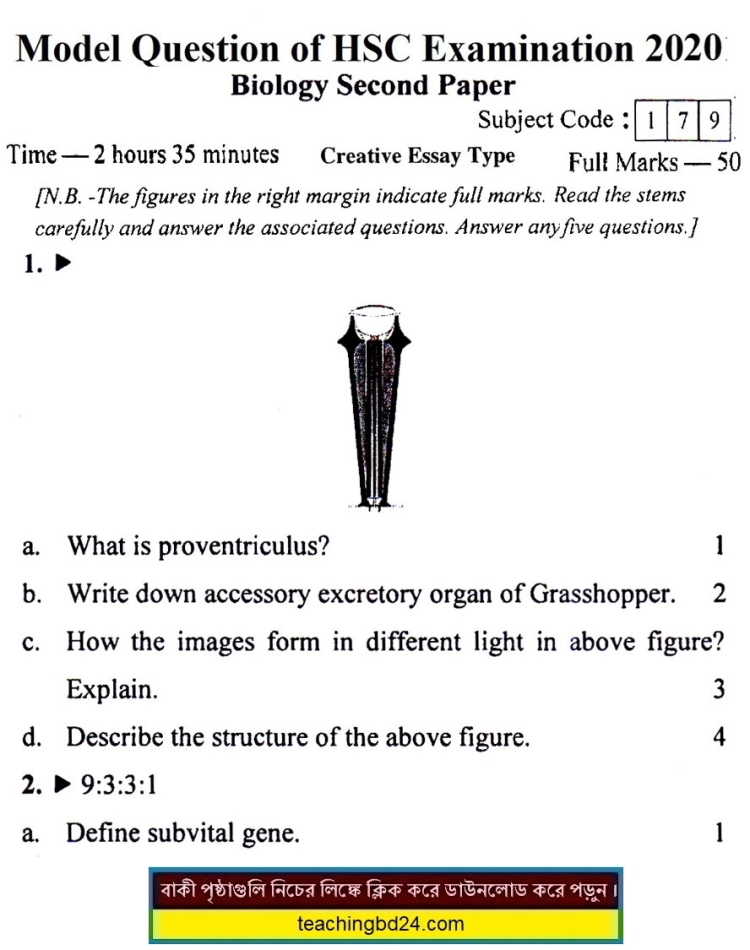EV HSC Biology 2 Suggestion Question 2020-5. HSC 2020 patterns suggestion and the question were published by the Board of Intermediate and Secondary Education, Dhaka. The Board of Intermediate and Secondary Education, Dhaka is an autonomous organization, responsible for the holding of two public examinations (SSC & HSC) and recognition of the newly created non-Govt. The educational institution, as well as of the supervision, control and the evolution of these institutions.
EV HSC Biology 2 Suggestion Question 2020-5

Model Question No. 5

HSC Biology Suggestion and Question Patterns of HSC Examination 2020. HSC 2020 patterns suggestion and the question were published by the Board of Intermediate and Secondary Education, Dhaka. The Board of Intermediate and Secondary Education, Dhaka is an autonomous organization, responsible for the holding of two public examinations (SSC & HSC) and recognition of the newly created non-Govt. an educational institution, as well as of the supervision, control and the evolution of these institutions.
A central organizing concept in biology is that life changes and develops through evolution and that all life-forms known have a common origin. The theory of evolution postulates that all organisms on the Earth, both living and extinct, have descended from a common ancestor or an ancestral gene pool.
This universal common ancestor of all organisms is believed to have appeared about 3.5 billion years ago. Biologists regard the ubiquity of the genetic code as definitive evidence in favor of the theory of universal common descent for all bacteria, archaea, and eukaryotes (see: the origin of life).
The term “evolution” was introduced into the scientific lexicon by Jean-Baptiste de Lamarck in 1809, and fifty years later Charles Darwin posited a scientific model of natural selection as evolution’s driving force. (Alfred Russel Wallace is recognized as the co-discoverer of this concept as he helped research and experiment with the concept of evolution.) Evolution is now used to explain the great variations of life found on Earth.
Darwin theorized that species flourish or die when subjected to the processes of natural selection or selective breeding. Genetic drift was embraced as an additional mechanism of evolutionary development in the modern synthesis of the theory.
The evolutionary history of the species—which describes the characteristics of the various species from which it descended—together with its genealogical relationship to every other species is known as its phylogeny. Widely varied approaches to biology generate information about phylogeny.
These include the comparisons of DNA sequences, a product of molecular biology (more particularly genomics), and comparisons of fossils or other records of ancient organisms, a product of paleontology. Biologists organize and analyze evolutionary relationships through various methods, including phylogenetics, phenetics, and cladistics. (For a summary of major events in the evolution of life as currently understood by biologists, see evolutionary timeline.)
Evolution is relevant to the understanding of the natural history of life forms and to the understanding of the organization of current life forms. But, those organizations can only be understood in light of how they came to be by way of the process of evolution. Consequently, evolution is central to all fields of biology.
Despite the profound advances made over recent decades in our understanding of life’s fundamental processes, some basic problems have remained unresolved. One of the major unresolved problems in biology is the primary adaptive function of sex, and particularly its key processes in eukaryotes of meiosis and homologous recombination.
One view is that sex evolved primarily as an adaptation that promoted increased genetic diversity (see references e.g. An alternative view is that sex is an adaptation for promoting accurate DNA repair in germ-line DNA, and that increased genetic diversity is primarily a byproduct that may be useful in the long run. (See also Evolution of sexual reproduction).
teachingbd24.com is such a website where you will get all kinds of necessary information regarding educational notes, suggestions and question patterns of schools, colleges, and madrasas. Particularly, you will get here special notes of physics that will be immensely useful to both students and teachers. The builder of the website is Mr. Md. Shah Jamal who has been serving for 32 years as an Assistant Professor of Physics at BAF Shaheen College Dhaka. He expects that this website will meet up all the needs of Bengali version learners /students. He has requested concerned students and teachers to spread this website home and abroad.
Discover more from Teaching BD
Subscribe to get the latest posts sent to your email.


